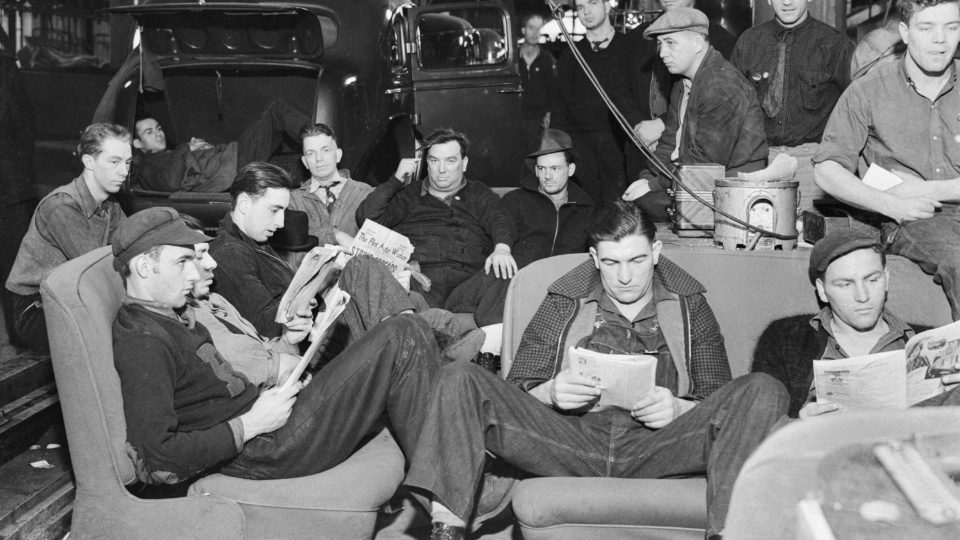
In the 1980s, Pat Fry was the Detroit reporter for People’s World. In 1985, Fry, who recently passed away, interviewed three workers who had taken part in the historic 1937 “Sit-Down Strike” at General Motors on the occasion of the 50th anniversary of the founding of the United Auto Workers (UAW) union. During that strike, this newspaper—then known as Daily Worker—was the only media outlet invited into the plant by the workers to cover their strike from the inside. In solidarity with the UAW strike currently underway against the Big Three automakers, People’s World presents these exclusive interviews from our archives as a tribute to both the labor movement and our friend, Pat Fry.
Originally published as “The sit-down that brought General Motors to its knees,” in the February 21, 1985 issue of Daily World.
DETROIT—This year marks the 50th anniversary of the founding of the United Automobile Workers Union. It was formally established in 1935 with the granting of a charter by the American Federation of Labor. However, the fight for union recognition and negotiated contracts was still to be won. On February 11, 1937, after a monumental 44-day “Sit-Down Strike” involving several General Motors plants, the fight for union rights was finally won for the first time in auto.
In 1936, on the eve of the sit-down, there were 460,000 auto workers nationwide. The country was recovering from the worst of the Great Depression. Unemployment was high and layoffs were frequent. Though GM was headquartered in Detroit, Flint was the home of the massive General Motors-Du Pont empire, the wealthiest and most powerful of corporate America.

The sit-down tactic—in which workers sit down on the job and occupy their plant—was a relatively new tool in the organizing drive strategy. In 1884, the brewery workers sat down; in 1906 workers at a GE plant sat down; and early in 1936, rubber workers in Akron, Ohio, sat down for six weeks, winning the struggle for recognition. The tactic had also been used successfully in several European countries.
This was the setting in Flint, Michigan, on December 30, 1936, when workers sat down and brought General Motors to its knees.
The following personal accounts were gathered in interviews with three leaders of the Flint Sit-Down Strike: Charlie Kramer, Howard Foster, and Nellie Bessom Hendrix, who helped organize the Auxiliary Brigade during the strike.
Conditions in the plant
Charles Kramer: We were desperate for help. You couldn’t work long enough to retire from the plant. They would retire you as a cripple or you would just wind up dead. The minute you couldn’t produce, out the door you went, and you were threatened with that daily. They would walk up and down the line and would say, “You like your job?”
“Yeah.”
“Well, by God, you better start showing a little more interest in it. Because we have somebody out there that wants it damn bad.”
And they would be standing there pulling that damn file as fast as you can and as hard as you can. I would go home at night and my hands would be swollen up so bad my wife would have to feed me my supper.
You just wouldn’t believe the conditions. The line broke down, and you’d sit and wait for them to fix it, and your [paid] time stopped until they started the line again.
After working on the body line for only a few days, with my arms working like a windmill, one of the foremen came up to me, and said, “Either you’re caught up by noon or you’re all done.”
I had an iron in my hand, and I threw that damn thing as far as I could throw it, and then I started after him. Well, I was 20 years old then—I thought I could lick Joe Lewis. Well, the foreman backed down, and from that time on, I never had that much fear of those people.
Howard Foster: The foreman was continuously going up and down the line telling you to get the work out, get the work out, and they were never satisfied. There was a man on the end of the line who was pushing it past you.

And you had just a small space on the line to work in, and the work became so fast that you couldn’t do a decent standard of work, so they put it through the line again, and you were supposed to correct the work when it came back through, and that meant taking something off and doing it again—that’s what speedup is.
I was getting 34-and-a-half cents an hour. I wasn’t married at the time, but I probably couldn’t have been, anyway. From the nervousness caused by the job, I couldn’t eat breakfast. If I had, I would have been sick in my stomach.
The Sit-Down
Charlie Kramer: The night before we sat down, [UAW Lead Organizer] Bob Travis pulled together many of the leaders from the plant for a midnight meeting. Bob said, “Well, now, what do we do?”
Four or five guys in the back of the room took a couple of pieces of paper out of their pockets and read, “What to do in the case of a sit down.” It was a whole organizational plan for what to do inside the plant and what to do outside the plant, derived from the Polish experience, the French experience, the Akron experience, and Midland Steel.
All this information had been compiled by the Communist Party. It was very explicit: You set up a soup kitchen, you have a plan for getting food into the plant, you set up a publicity committee, you set up guards at the doors, you start out by electing a committee, etc. The meeting went on that night until two or three in the morning, it seems to me. We were all dead tired at the end of it. We agreed, with modifications, to the plan.
I’ll tell you how it went at the Wisher No. 2 Plant the next day. As soon as we all got to work, all the foremen, of course, saw all these union buttons. The superintendent was going up and down the line talking to all the foremen.

They never said a damn word until we started working, and then pretty soon the superintendent went up to one of the inspectors and said, “You boys will have to take your union buttons off.”
I said, “How come they have to take their buttons off?” He said, “Well, they are potential foremen.” I said, “Well, hell, aren’t I a potential foreman? Anyone of us here is a potential foreman.”
And he said, “Well, they are going to have to either take their buttons off, or they can’t work.” Then he took off, went up the line to two guys who didn’t belong to our union, and put them on inspection. Our guys just kept right on inspecting, with these two scabs working further down the line, and we didn’t pay them any attention.
Then the foreman comes up to us and says, “They either got to take off those buttons or they’re fired.” I said, “You mean that?” He said, “That’s right, that’s it.”
And I said, “OK, that’s it,” and I got up on one of these dollies and raised my arm up and down, and we went down. One guy, Bruce Manley, went up the stairs, and he let out a holler, “We’re down,” and boy, she went down upstairs just like that.
Howard Foster: The superintendent was on a bench and was trying to get the guys to go back to work, making a speech, and one fellow threatened to knock him off the bench if he didn’t shut up. He ordered everybody to leave the plant, and there was a grand exodus for the door.
I didn’t know how many people were going out. I was asking them to stay. Among the men I asked to stay was a Black worker, who stayed with us all through the sit-down strike. He was a janitor at the time; that was about the only job open to Black people in the plant.
The immediate problem I had after we’d mostly secured the plant was the supervisors. They had congregated in the middle of the plant at a position where the motor line went right through the plant.
I took a group of men and told the supervisors that we were taking the plant and barricading it, that we were going to chain the front gate and lock it, and that they had 10 minutes to get out of the plant. There was a belligerency on the part of some, but the majority of them moved to get out of the plant. They all left eventually. They didn’t want to fight by themselves.

Well, unions were built on committees, and we knew we had to have a strike committee, so we had a meeting to elect it, and I nominated Kermit Johnson to be chairman. He was a capable man. He was elected. The first order of business raised was that we not stay in the plant, that we leave.
I spoke for staying in the plant, that that was what was required of us, and the motion carried. There was a movement of dissatisfaction, though, and there was a group still wanting to leave the plant. They were convinced not to leave by the loud sound of cars coming outside the plant telling us over the loudspeakers to barricade the plant, hold the plant, that that’s what the union wanted.
Then there was a general consensus that we would stay in the plant. There was no more voting. They just needed that touch from the outside.
After 44 days, General Motors gave in. They agreed to recognize the union and to negotiate. They also agreed to union demands that no disciplinary action would be taken against those who participated in the sit-down, or for participation in any other union activities.
It was a tremendous victory for the entire working class.
Workers at Chrysler and at independent shops then began a wave of sit-downs. In Detroit, 200,000 people rallied in support of the strikers. In 1941, the UAW won the fight to represent Ford workers and succeeded in negotiating the best contract that had ever been won.
Nellie Bessom Hendrix: It took the efforts of every single one of us—the efforts of our own people who were working, the efforts of the Auxiliary Brigade, the other unions, the efforts of the Governor of Michigan, John L. Lewis, and the parties—it took all of us.
We hope you appreciated this article. At People’s World, we believe news and information should be free and accessible to all, but we need your help. Our journalism is free of corporate influence and paywalls because we are totally reader-supported. Only you, our readers and supporters, make this possible. If you enjoy reading People’s World and the stories we bring you, please support our work by donating or becoming a monthly sustainer today. Thank you!












Comments